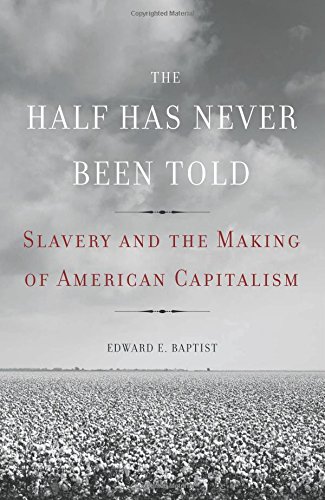The Half Has Never Been Told: Slavery and the Making of American Capitalism
- By Edward E. Baptist
- Basic Books
- 488 pp.
- Reviewed by Elizabeth Dowling Taylor
- November 1, 2014
An illuminating look at how the U.S. economy was, indeed, built on the backs of slaves.

Edward E. Baptist’s The Half Has Never Been Told: Slavery and the Making of American Capitalism is an achievement of the first order. It is unfortunate, then, that the introduction begins with the confounding statement that neither slave owners nor early historians admitted slavery was an institution “committed to profit-seeking.” Of course they did. Write this off as an effort to enhance a book’s marketability by claiming a never-considered premise.
On the other hand, Baptist utterly follows through on his promise in the same introduction to show us “how slavery changed and moved and grew over time,” from its near exhaustion in the upper South to its ever-spreading explosion in the Deep South following the invention of the cotton gin.
With Baptist’s meticulous research and comprehensive, chronological approach, the other half of the story has now been told, and told very well. The reader is readily engaged in this scholarly treatment of over 400 pages, thanks to Baptist’s narrative style and his skillful interweaving of personal stories from slave and enslaver memoirs and letters with complex political and economic context.
When the federal government outlawed Atlantic slave traffic beginning in 1808, the domestic trade picked up speed, and the forced migration of moving feet was herded in one direction: south. By this time, many tobacco planters in Virginia and Maryland found their soil worn out and devalued, but owned a “surplus” of slaves, people that, configured as property, were worth ever-higher prices in Georgia, Alabama, and Mississippi.
A prime field hand who might fetch $400 if sold to a neighbor would bring three times that amount released to a trader looking to resell in New Orleans. “From the 1790s to the 1860s, enslavers moved 1 million people from the old slave states to the new,” writes Baptist.
Slave sellers, traders, and buyers were not the only ones cashing in on cotton produced by enslaved laborers, however. One of Baptist’s main points is that slaves were not only facilitating flush times locally and regionally, but also were serving as engines for wealth made by textile manufacturers elsewhere.
“By the 1840s the North had built a complex, industrialized economy on the backs of enslaved people and their highly profitable cotton labor.” And that labor not only powered American capitalism, it also shaped the world economy, with England a major consumer of slave-grown cotton.
Though his prose is a bit overwrought in places, Baptist’s depiction of the breakup of families, slave coffles in chains, and relentless field toil is heartbreakingly affective and never allows us to forget that it is ultimately impossible to make property of people.
But the oppressor tried his upmost to turn men, women, and even young children into machines. “He held the carrots, and he held the sticks.” Overseers in the cotton fields employed a quota system: If a field hand’s sack did not hold the requisite amount of cotton by the end of a long, hot day, the “difference” would be made up in lashes.
The amount of cotton picked grew dramatically over time because, extorted by whipping, the daily quotas demanded got higher and higher. The picking volume did not have to be a bottleneck, after all.
Statistics prove that these techniques allowed increasing profits to be stolen from the abused laborers. Yes, violence could and did trump the supposed self-motivation of free labor that many claimed made slave labor inherently less economical.
Money drove almost every decision, and success led to greed for more land (and more slaves) to exploit. All the while, white Southerners were — with Constitutional blessing — counting slaves as three-fifths a person for purposes of representation in Congress, thus giving enslavers extra political clout, which they then used in diametrical opposition to the wishes of this block of “constituents.”
Baptist uses the phrase “slave labor camps” in place of plantations, and with his description of enslavers’ and overseers’ incredible harshness, this substitution seems entirely appropriate, especially given the mythic associations that come with references to Southern plantations.
Another myth the author busts is the old chestnut that slavery was dying out on its own, and a civil war was not necessary for its demise.
Not so.
The slavery business was booming. Between 1840 and 1859, the cotton crop increased 450 percent in total value, and enslavers set their sights on exploiting land to the west. “The 3.2 million people enslaved in the United States had a market value of $2 billion in 1850 — one-third of the nation’s wealth and almost equal to the entire gross national product.”
This book on “slavery’s second life in the United States” is highly recommended to those who want to understand the evolution of our African-American heritage and its centrality to the nation’s political and economic history, not to mention the shameful blow to America’s stated ideals. How sad to say that if one wishes to pick up that evolution where Baptist leaves off, read Slavery by Another Name: The Re-Enslavement of Black Americans from the Civil War to World War II by Douglas Blackmon.
Elizabeth Dowling Taylor, a fellow at the Virginia Foundation for the Humanities, is author of A Slave in the White House: Paul Jennings and the Madisons. She is currently writing a book on the rise and disillusionment of the black elite, 1850-1925. It will be published by Amistad Press.

_80_122.png)